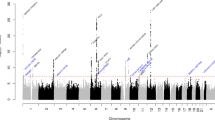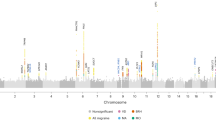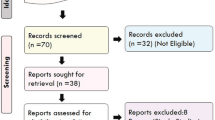Abstract
Familial hemiplegic migraine is an autosomal dominant disorder of unknown pathogenesis in which the migrainous attacks are marked by the occurrence of a transient hemiplegia during the aura. While investigating CADASIL, mapped previously to chromosome 19, we observed that some patients had recurrent attacks of migraine with aura. Although the clinical and neuroimaging features of familial hemiplegic migraine differ markedly from CADASIL, we hypothesized that the same gene could be involved in the pathogenesis of both conditions. We chose two large pedigrees for linkage analysis of familial hemiplegic migraine. A maximum lod score > 8 was found with two markers that are also strongly linked to CADASIL Multilocus linkage analysis suggested that the loci responsible for the two diseases reside within an interval of about 30 cM on chromosome 19.
This is a preview of subscription content, access via your institution
Access options
Subscribe to this journal
Receive 12 print issues and online access
$209.00 per year
only $17.42 per issue
Buy this article
- Purchase on Springer Link
- Instant access to full article PDF
Prices may be subject to local taxes which are calculated during checkout
Similar content being viewed by others
References
Stewart, W.F., Lipton, R.B., Celentano, D.D. & Reed, M.L. Prevalence of migraine headache in the United States. JAMA 267, 64–69 (1992).
Henry, P., Michel, P., Dartigues, J.F., Tison, F. & Vivares, C. Epidémiologie de la maladie migraineuse. Circ. Métab. du Cerv. 7, 229–236 (1990).
Lance, J.W. Mechanism and management of headache 4th edn (Butterworths Scientific, London, 1982).
Headache Classification Committee of the International Headache Society. Classification and diagnostic criteria for headache disorders, cranial neuralgias and facial pain. Cephalalgia 8, Supp. 7 19–28 (1988).
Blau, J.N. & Whitty, C.W.M. Familial hemiplegic migraine. Lancet 2, 1115–1116 (1955).
Clarke, J.M. On recurrent motor paralysis in migraine. Br. Med. J. 1, 1534–1538 (1910).
Glista, G. & Mellinger, J.F. Familial hemiplegic migraine. Mayo Clin. Proc. 50, 307–311 (1975).
Whitty, C.W.M. Familial hemiplegic migraine. J.Neurol. Neurosurg. Psychiatry 16, 172–177 (1953).
Münte, T.F. & Müller-Vahl, H. Familial migraine coma: a case study. J. Neurol. 237, 59–61 (1990).
Fitzimons, R.B. & Wolfenden, W.H. Migraine coma. Meningitic migraine with cerebral oedema associated with a new form of autosomal dominant cerebellar ataxia. Brain 108, 555–577 (1985).
Young, G.F. et al. Familial hemiplegic migraine, retinal degeneration, deafness, and nystagmus. Arch. Neurol. 23, 201–209 (1970).
Zifkin, B., Andermann, E., Andermann, F. & Kirkham, T. An autosomal dominant syndrome of hemiplegic migraine, nystagmus, and tremor. Ann. Neurol. 8, 329–332 (1980).
Ohta, M., Araki, S. & Kuroiwa, Y. Familial occurence of migraine with a hemiplegic syndrome and cerebellar manifestations. Neurology 17, 813–817 (1967).
Codina, A., Acarini, P.N. & Miguel, F. Migraine hémiplégique associée à un nystagmus. Rev. Neurol. (Paris) 124, 526–530 (1971).
Tournier-Lasserve, E., Iba-Zizen, M.T., Romero, N. & Bousser, M.G. Autosomal dominant syndrome with stroke-like episodes and leukoencephalopathy. Stroke 22, 1297–1302 (1991).
Baudrimont, M., Dubas, F., Joutel, A., Tournier-lasserve, E. & Bousser, M.G. Autosomal dominant leukoencephalopathy and subcortical ischemic stroke : a clinicopathological study. Stroke 24, 122–125 (1993).
Tournier-Lasserve, E. et al. Cerebral autosomal dominant arteriopathy with subcortical infarcts and leukoencephalopathy maps to chromosome 19q12. Nature Genet. 3, 256–259 (1993).
Pages, M., Barège, M., Blard, J.M. & Labauge, R. La migraine hémiplégique familiale. Sem. Hôp. Paris. 12, 337–342 (1993).
Weissenbach, J. & et al. A second generation linkage map of the human genome. Nature 359, 794–801 (1992).
Lathrop, G.M., Lalouel, J.M., Julier, C. & Ott, J. Multilocus linkage analysis in humans: detection of linkage and estimation of recombination. Am. J. hum. Genet. 37, 482–498 (1985).
Author information
Authors and Affiliations
Rights and permissions
About this article
Cite this article
Joutel, A., Bousser, MG., Biousse, V. et al. A gene for familial hemiplegic migraine maps to chromosome 19. Nat Genet 5, 40–45 (1993). https://doi.org/10.1038/ng0993-40
Received:
Accepted:
Issue Date:
DOI: https://doi.org/10.1038/ng0993-40
This article is cited by
-
Current Update on Categorization of Migraine Subtypes on the Basis of Genetic Variation: a Systematic Review
Molecular Neurobiology (2023)
-
Complex effects on CaV2.1 channel gating caused by a CACNA1A variant associated with a severe neurodevelopmental disorder
Scientific Reports (2022)
-
Identification of common genetic markers of paroxysmal neurological disorders using a network analysis approach
Neurological Sciences (2020)
-
Ion channelopathies and migraine pathogenesis
Molecular Genetics and Genomics (2017)
-
Migraine headache: a review of the molecular genetics of a common disorder
The Journal of Headache and Pain (2012)



